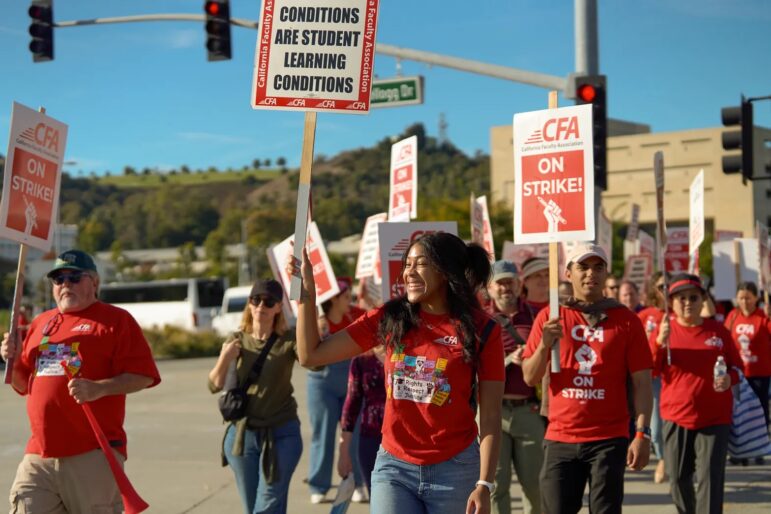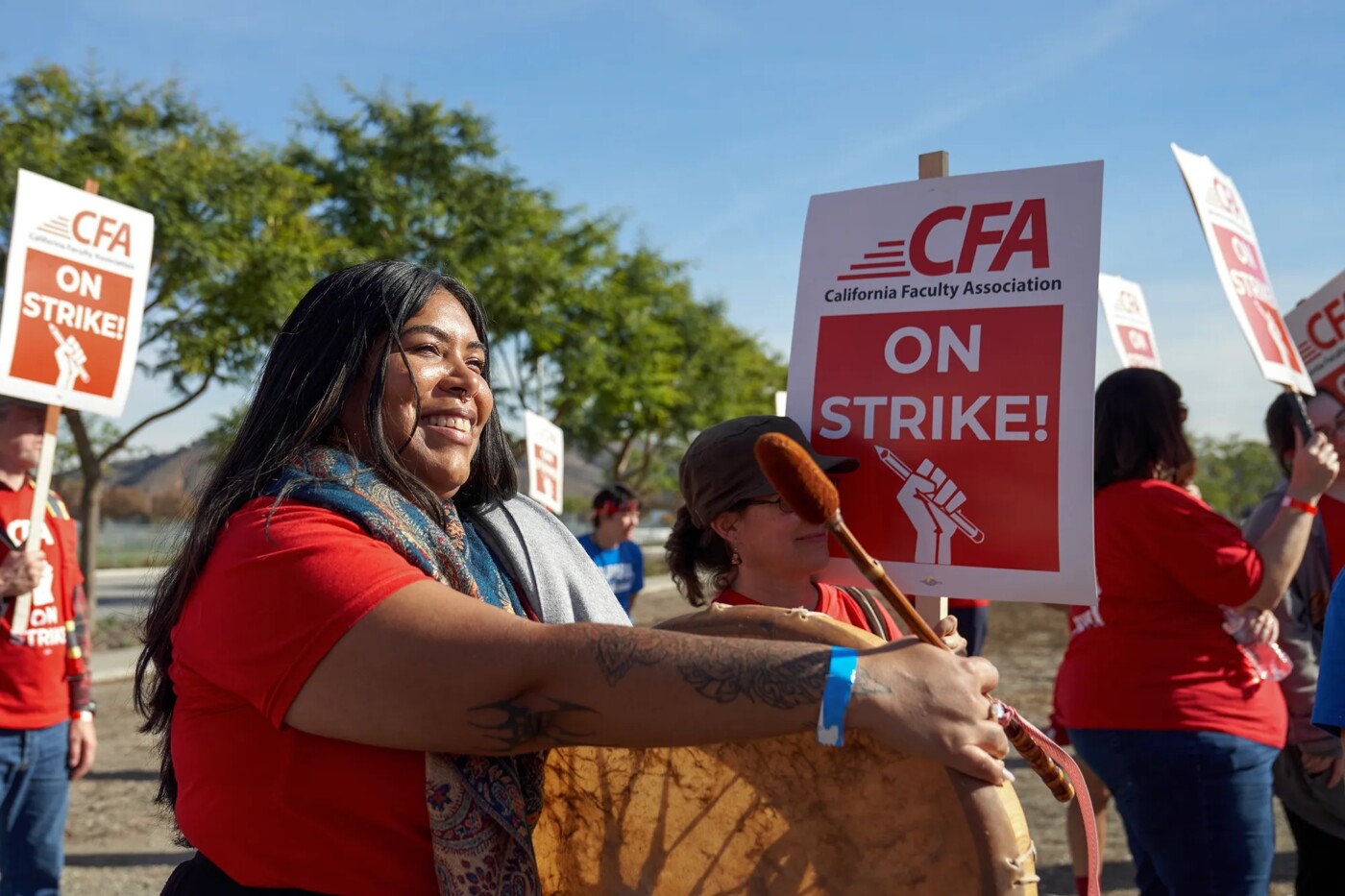As far back as May the faculty at the California State University threatened to strike if management wouldn’t meet their wage and benefit demands.
That prophecy is on full display today as the California Faculty Association has begun the first of four one-day strikes, starting at Cal Poly Pomona.
Tomorrow through Thursday the association is planning one-day strikes at Cal State campuses in Los Angeles, Sacramento, and San Francisco. The four campuses with walkouts this week together enroll about 105,000 students. The union vows to escalate the work stoppages early next year if university leaders don’t meet their demands.
“If that doesn’t work, we’ll be back,” said union president Charles Toombs. He spoke during an afternoon rally today.
“Nobody gives you nothing in this world and you are showing that what is important to you in the CSU is that you have working conditions where you can afford to live, where you can have class sizes that are just not outrageous,” Toombs said.
The union represents 29,000 professors, lecturers, librarians, counselors and coaches. It is demanding 12% raises this academic year to make up for the recent massive spikes in inflation. The union also seeks to extend parental leave from six weeks to a full semester, hire more therapists and set new baseline wages for the lowest-paid professors and other concessions.
“We don’t need sleep-deprived teachers being put in the classroom mid-semester,” declared Nick Von Glahn, a psychology professor at Cal Poly Pomona and the campus union president, during the rally today.
At one point a team of folklórico dancers performed to a live rendition of Creedence Clearwater Revival’s foreboding hit song, Bad Moon Rising.
The Cal State system, the nation’s largest four-year public university with more than 450,000 students, says it cannot afford the raises.
Instead, its leadership has proposed a 5% hike this academic year and 5% increases in 2024-25 and 2025-26 — contingent on Gov. Gavin Newsom fulfilling his promise of upping state support for the system by 5% for each of those two years, moves that require the Legislature’s approval. It’s a promise he’s kept the past two years despite a multi-billion-dollar deficit in June, but faculty labor leaders object to any future raises that aren’t guaranteed.
“Any larger salary increases would force very difficult and painful decisions on our campuses,” said Leora Freedman, vice chancellor for human resources at the Cal State system during a virtual press conference Friday.
The Cal Poly Pomona rally featured elected officials and candidates for state Assembly offices, some for the same Assembly seat.
“I’m a success right now because of Cal State L.A., because of the faculty, not because of administration,” said Sasha Renée Pérez, who attended Cal State L.A. and is now vice mayor of the city of Alhambra. She’s also running for a state Senate seat.
Assemblymember Sabrina Cervantes, a Democrat from Corona, spoke in support of the faculty demands, telling them that “this is what collective action for justice looks like.” She’s chair of the California Latino Legislative Caucus.
Professors at Cal State earn between $91,000 and $122,000 on average, full-time lecturers make $71,000 on average and the 23 campus presidents have an average base salary of about $417,000, according to 2022 data compiled by CalMatters. Most lecturers are part-time and earned the equivalent $64,000 on average in 2022. The union also wants pay bumps for the lowest-paid instructors on top of the 12% wage increases. Many earned less because they don’t work the full academic year.
Faculty and other employees are incensed that some campus presidents earned raises of 29% last year. A CalMatters analysis last week showed that while lecturers saw average raises of 22% since 2007, presidents since then saw base pay raises of 43% on average. The system’s new chancellor earns just shy of $800,000 million in base pay and about $1 million when adding housing, auto and other perks.
A 12% increase for the faculty association’s members would cost Cal State $380 million in annual payroll commitments — an amount that exceeds the operating budgets of numerous individual Cal State campuses. That’s $150 million more than the system got from Newsom’s 5% increase in state support this summer.

Freedman on Friday also said that raises above 5% for the faculty “would trigger a reopening of salary negotiations with other labor unions.” She was referring to recent deals Cal State finalized with two other unions representing 20,000 workers in which they agreed to 5% raises this year. Those contracts included provisions permitting those unions to bargain again over salary increases if another union gets more than 5%.
A state labor mediator weighed in with a much-anticipated fact-finding report that was published Friday saying that Cal State should agree to a 7% raise for the faculty union. The report also proposed other technicalities that would increase faculty pay without triggering the salary re-openers with other unions. The Cal State leadership opposes that 7% solution, according to a memo its labor relations staff published. A faculty union senior leader also signaled to CalMatters last week that a 7% wage increase is too low for its members.
“If they come at us with seven (percent), I don’t think faculty would accept that,” said Kevin Wehr, bargaining team chair for the California Faculty Association and a professor at Sacramento State.
Both sides suggested there’s room for negotiation over the technical wage increases the fact-finding report recommended.
The union is also hesitant to accept a multi-year deal because it would override contract negotiations slated to begin next summer. Right now, the two sides are able to negotiate on just a few matters in the collective bargaining agreement, including salary and several benefits provisions. Accepting a multi-year deal now locks into place other contact details that the union wants to hammer out next year.
“The three-year nature of management’s proposal would mean that we cannot bargain over other workplace issues for three years!” union leaders wrote to members last week.
The mediator’s fact-finding report identified 15 issues overall that the union and Cal State are at an impasse over in the current negotiations. Cal State is prepared to accept 13 of the report’s recommendations, excluding salary and a separate issue about faculty workload.
“I can barely make basic living expenses on our current salary,” said Rachael Hill, a history professor at Cal Poly Pomona. She earns around $80,000 and has a son in college.
“We’re asking to break even given the rate of inflation, right? And management has offered a 5% (raise), which is essentially a pay cut.”
She’s one paycheck from being houseless, she said, and not only is she unable to pay down her student debt, but she’s accumulating other debt given her wages, she said.
She also wants to see more mental health counselors at her campus. “I’ve had students who were really in crisis, who couldn’t get an appointment, and I had to call the (campus) emergency response team to go in and to do a wellness check on them,” she said. “Knowing that their needs are being taken care of in a timely manner is going to alleviate a lot of stress and worry on my part,” she added.
Chelsi Dimm, a lecturer at Cal Poly Pomona and Fullerton, teaches 11 classes combined for the year, which yields an annual income of around $72,000, she said. She lives in Los Angeles and sometimes drives to both campuses on the same day, a commute of more than two hours.
“A lot of us lecturers are having to put together several jobs in order to make a living,” she said, “and that’s really just not conducive to student learning conditions.”
Complicating the revenue picture further is that the Cal State’s trustees in September approved tuition hikes of 34% across five years that will take effect next fall — actions the faculty union and student groups vehemently opposed. About 60% of students won’t be affected because they receive enough state and institutional financial aid to offset tuition charges. Prompting the trustees’ decision was the revelation in May that Cal State spends $1.5 billion less than it should to properly educate its students and needs more money.
But even with the revenue generated from the tuition hikes and the 5% increases in state support from lawmakers, Cal State officials said they won’t have enough to afford 15% salary increases over three years for all its employees. An official in September said that under that scenario, the system would be $322 million short over three years. Program cuts, layoffs, not filling positions and other approaches are all possibilities to close that gap. Individual campuses would have to decide “how they would address impacts to their budget and reallocate their already limited financial resources,” said Cal State spokesperson Amy Bentley-Smith.
The faculty union argues that Cal State has more available money than it lets on, noting that the system in recent years has shifted end-of-year surpluses into cash and investment reserves. Cal State says it needs at least three months of operating cash on hand to hedge against financial shocks, like natural disasters or recessions. The cash reserves it has now equal just 33 days of its annual budget.
The fact-finder report noted that the two sides fundamentally disagree on the system’s financials and ability to shift more money from reserves and construction projects to ongoing expenses like salaries. CalMatters asked Freedman if the system is choosing to route more money to reserves than to faculty pay.
“It’s a balance,” she said Friday. “We need to be responsible and protect the university and our students and our operations. And at the same time, we also need to pay our employees fairly and competitively and we are in a very tough situation.”
Meanwhile, Cal State points to a faculty pay study a consulting firm produced this year that showed Cal State faculty are paid comparable salaries compared to similar out-of-state universities. The faculty union and various system trustees criticized that study for not considering California’s higher cost of living and for not including California universities in the comparison group.
